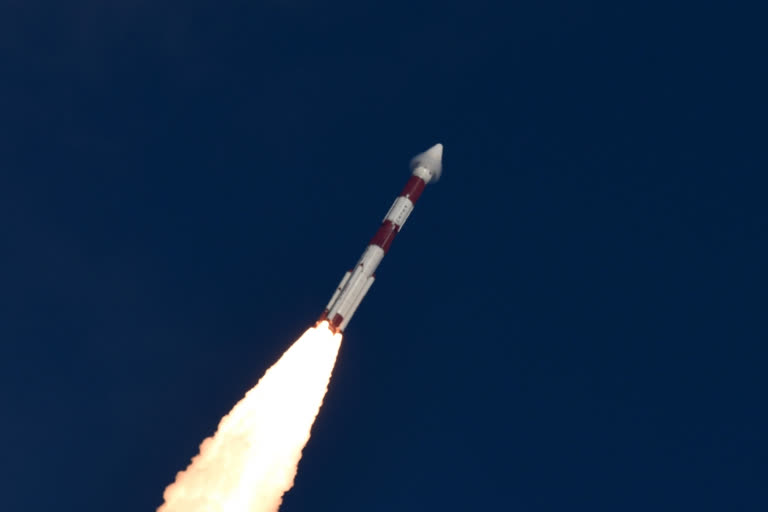Sriharikota (AP): India's Polar Satellite Launch Vehicle-C52 (PSLV-C52) on Monday early morning lifted off with the country's latest radar imaging satellite EOS-04 and two other small satellites from the rocket port here in Andhra Pradesh. The PSLV rocket carrying 1,710 kg EOS-04 (formerly RISAT-1A) as its primary passenger and two small satellites INSPIREsat-1 and INS-2TD as co-passengers blasted off from the first launch pad at Satish Dhawan Space Centre (SDSC) here at 5.59 am.
The 44.4-metre tall PSLV-C52 rocket weighing 321 tons slowly rose up towards the skies with a thick orange flame at its tail. The rocket gained speed as it went up while emitting a rolling thunder sound. If all goes well, India's first space mission for 2022 will be over in about 18 minutes. The PSLV is a four-stage/engine rocket powered by solid (first and third stages) and liquid (second and fourth stages) fuels alternatively. The rocket is the XL variant with six booster motors having 12-ton fuel hugging the first stage to give higher thrust during the initial flight moments.
The other PSLV variants are - PSLV-DL with two strap-on motors, PSLV-QL with four strap-on motors and Core Alone without any booster motors. The choice of the rocket to be used depends on the weight of the satellite and the orbit where the satellite has to be orbited. As per the flight plan, just over 17 minutes into its flight the PSLV-C52 will sling the EOS-04 into a sun-synchronous polar orbit of 529 km and it will be followed by INSPIREsat-1 (17.5 kg) and INS-2TD (8.1 kg) satellites.
India's EOS-04 with 10 years life span is designed to provide high-quality images under all weather conditions for applications such as agriculture, forestry & plantations, soil moisture & hydrology and flood mapping, said ISRO. The satellite will play a strategic role in the nation's defence with its capability to operate in the day, night and all weather conditions. The EOS-04 satellite has high data handling systems and high storage devices among other things. The radar imaging satellite is a repeat of Risat-1 that was launched in 2012 and is configured to ensure continuity of SAR in C-Band providing microwave data to the user community for operational services.
The INSPIREsat-1 is a student satellite from the Indian Institute of Space Science & Technology (11ST) in association with the Laboratory of Atmospheric & Space Physics at the University of Colorado, USA. The other contributors are NTU, Singapore and NCU, Taiwan. The satellite carries two scientific payloads to improve the understanding of ionosphere dynamics and the sun's coronal heating process. The technology demonstrator satellite (INS-2TD) from ISRO, which is a precursor to India-Bhutan Joint Satellite (INS-2B) carries a thermal imaging camera to assess land/water surface temperature of wetlands/lakes, delineation of vegetation (crops/forests) and day/night thermal inertia.
The RISAT-1A flight will be followed by the launch of three satellites - OCEANSAT-3, INS-2B, ANAND- by PSLV-C53 in March and Micro SAT by the newly developed small rocket Small Satellite Launch Vehicle (SSLV) in April. Further, the launch of the four-ton communication satellite GSAT-24 is also scheduled during the first quarter of this year using the Ariane 5 rocket owned by Arianespace.



